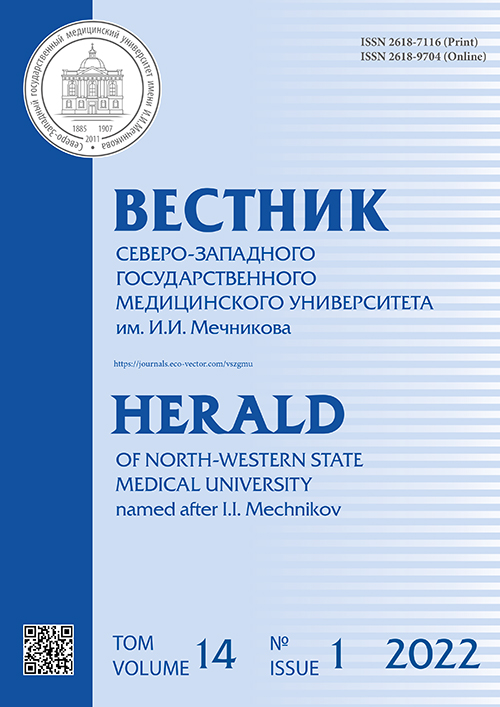Liver injury and novel coronavirus infection: development mechanisms and clinical manifestation
- Authors: Livzan M.A.1, Gaus O.V.1, Gavrilenko D.A.1
-
Affiliations:
- Omsk State Medical University
- Issue: Vol 14, No 1 (2022)
- Pages: 97-104
- Section: Case report
- Submitted: 20.03.2022
- Accepted: 10.04.2022
- Published: 17.06.2022
- URL: https://journals.eco-vector.com/vszgmu/article/view/105163
- DOI: https://doi.org/10.17816/mechnikov105163
- ID: 105163
Cite item
Abstract
The novel coronavirus infection (COVID-19) caused by SARS-CoV-2 is characterized by a variety of clinical manifestations. As the infection spreads and the number of observations increases, it is clear that SARS-CoV-2 affects not only the respiratory tract, but also the digestive system. More than half of patients with COVID-19 have changes in the biochemical blood test, indicating liver damage. The reasons for this may be direct cytopathic or mediated immune effect, organ ischemia, the intake of drugs with potential hepatotoxic effects, onset of previously undiagnosed or worsening of the course of an existing liver disease. This article provides a brief overview of the possible etiological factors of liver damage in COVID-19 and presents its own clinical case.
Full Text
About the authors
Maria A. Livzan
Omsk State Medical University
Email: mlivzan@yandex.ru
ORCID iD: 0000-0002-6581-7017
SPIN-code: 1961-4082
Scopus Author ID: 24341682600
MD, Dr. Sci. (Med.), Professor
Russian Federation, OmskOlga V. Gaus
Omsk State Medical University
Author for correspondence.
Email: gaus_olga@bk.ru
ORCID iD: 0000-0001-9370-4768
SPIN-code: 7116-8419
Scopus Author ID: 56598554900
ResearcherId: AAB-1979-2019
MD, Cand. Sci. (Med.), Assistant Professor
Russian Federation, OmskDarya A. Gavrilenko
Omsk State Medical University
Email: gavrilenko.darigav@yandex.ru
ORCID iD: 0000-0001-5245-7190
SPIN-code: 1435-9150
Russian Federation, Omsk
References
- Mao R, Liang J, Shen J, et al. Implications of COVID-19 for patients with pre-existing digestive diseases. Lancet Gastroenterol Hepatol. 2020;5(5):425–427. doi: 10.1016/S2468-1253(20)30076-5
- Gu J, Han B, Wang J. COVID-19: Gastrointestinal manifestations and potential fecal-oral transmission. Gastroenterology. 2020;158(6):1518–1519. doi: 10.1053/j.gastro.2020.02.054
- Cai Q, Huang D, Yu H, et al. COVID-19: Abnormal liver function tests. J Hepatol. 2020;73(3):566–574. doi: 10.1016/j.jhep.2020.04.006
- Wu Y, Li H, Guo X, et al. Incidence, risk factors, and prognosis of abnormal liver biochemical tests in COVID-19 patients: a systematic review and meta-analysis. Hepatol Int. 2020;14(5):621–637. doi: 10.1007/s12072-020-10074-6
- Hunt RH, East JE, Lanas A, et al. COVID-19 and gastrointestinal disease: implications for the gastroenterologist. Dig Dis. 2021;39(2):119–139. doi: 10.1159/000512152
- Zhao Y, Zhao Z, Wang Y, et al. Single-Cell RNA expression profiling of ACE2, the receptor of SARS-CoV-2. Am J Respir Crit Care Med. 2020;202(5):756–759. doi: 10.1164/rccm.202001-0179LE
- Zhang H, Kang Z, Gong H, et al. The digestive system is a potential route of 2019-nCov infection: a bioinformatics analysis based on single-cell transcriptomes. bioRxiv. 2020. doi: 10.1101/2020.01.30.927806
- Hu LL, Wang WJ, Zhu QJ, Yang L. Novel coronavirus pneumonia-related liver injury: etiological analysis and treatment strategy. Zhonghua Gan Zang Bing Za Zhi. 2020;28(2):97–99. (In Chinese). doi: 10.3760/cma.j.issn.1007-3418.2020.02.001
- Liu J, Li S, Liu J, et al. Longitudinal characteristics of lymphocyte responses and cytokine profiles in the peripheral blood of SARS-CoV-2 infected patients. EBioMedicine. 2020;55:102763. doi: 10.1016/j.ebiom.2020.102763
- Waseem N, Chen PH. Hypoxic hepatitis: a review and clinical update. J Clin Transl Hepatol. 2016;4(3):263–268. doi: 10.14218/JCTH.2016.00022
- Lightsey JM, Rockey DC. Current concepts in ischemic hepatitis. Curr Opin Gastroenterol. 2017;33(3):158–163. doi: 10.1097/MOG.0000000000000355
- Dunn GD, Hayes P, Breen KJ, Schenker S. The liver in congestive heart failure: a review. Am J Med Sci. 1973;265(3):174–189. doi: 10.1097/00000441-197303000-00001
- Rosser BG, Gores GJ. Liver cell necrosis: cellular mechanisms and clinical implications. Gastroenterology. 1995;108(1):252–275. doi: 10.1016/0016-5085(95)90032-2
- Bertolini A, van de Peppel IP, Bodewes FAJA, et al. Abnormal liver function tests in patients with COVID-19: Relevance and potential pathogenesis. Hepatology. 2020;72(5):1864–1872. doi: 10.1002/hep.31480
- Yang X, Yu Y, Xu J, et al. Clinical course and outcomes of critically ill patients with SARS-CoV-2 pneumonia in Wuhan, China: a single-centered, retrospective, observational study. Lancet Respir Med. 2020;8(5):475–481. doi: 10.1016/S2213-2600(20)30079-5
- Genovese MC, Kremer JM, van Vollenhoven RF, et al. Transaminase levels and hepatic events during tocilizumab treatment: pooled analysis of long-term clinical trial safety data in rheumatoid arthritis. Arthritis Rheumatol. 2017;69(9):1751–1761. doi: 10.1002/art.40176
- Metawea MI, Yousif WI, Moheb I. COVID 19 and liver: An A-Z literature review. Dig Liver Dis. 2021;53(2):146–152. doi: 10.1016/j.dld.2020.09.010
- Yang RX, Zheng RD, Fan JG. Etiology and management of liver injury in patients with COVID-19. World J Gastroenterol. 2020;26(32):4753–4762. doi: 10.3748/wjg.v26.i32.4753
- Livzan MA, Akhmedov VA, Krolevets TS, et al. Informative value of non-invasive markers of liver fibrosis in patients with non-alcoholic fatty liver disease. Ter Arkh. 2016;88(12):62–68. (In Russ.). doi: 10.17116/terarkh2016881262-68
Supplementary files











